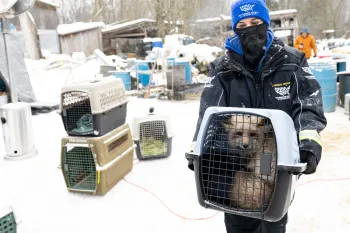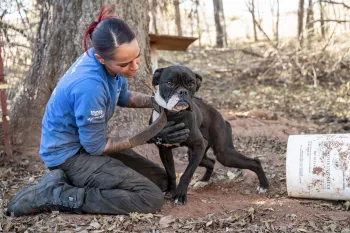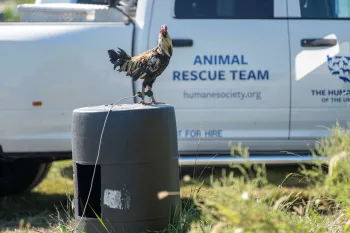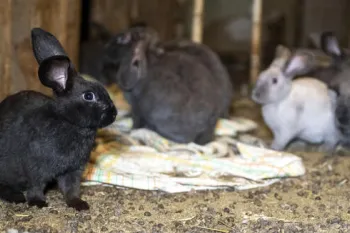A thin coyote who had been kept in a small wire cage on a fur and urine farm in Ohio recently arrived at a wildlife rehabilitator’s home. Some states still allow native carnivores like coyotes to be held captive so people can collect their urine so it can be used (or marketed) for dubious purposes, including to deter deer from gardens. Now saved from that farm, this coyote is learning what safety and care feel like. “She receives two warm meals a day along with her kibble,” said Gwen Hoogendoorn, her rehabilitator, who is trying to get the coyote’s weight back up before finding her permanent placement in a wildlife sanctuary.
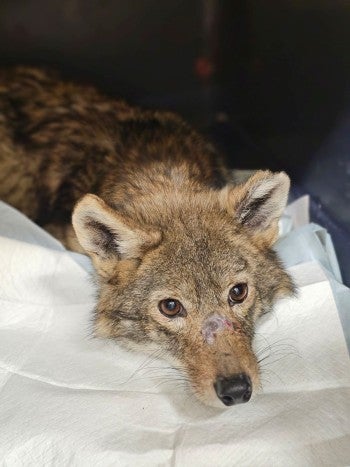
Gwen Hoogendoorn
We heard from another wildlife rehabilitator that a couple of foxes saved from the farm started spontaneously playing hide-and-seek in their enclosure, then chased each other around with glee. It’s probably the first time they ever felt safe enough to play.
These animals are just a few of more than 250 animals who have now been safely relocated from this abysmal operation in Hartsgrove, Ohio, to rehabilitators and sanctuaries. Our rescuers are calling this one of the most horrific situations they have ever seen.
Tragically, the only way to help some animals was to humanely end their suffering through euthanasia; some had severe injuries and illness, and others simply had no safe place to go. Releasing animals unaccustomed to living in wild environments would have been inhumane, unsafe and potentially damaging to local ecosystems.
The rescue operation began earlier this month when the Ashtabula County Commissioner’s Office requested our help after the owner of this farm, known as Grand River Fur Exchange, passed away in late December 2024. The team found the circumstances both daunting and disturbing once they arrived.

Meredith Lee/The HSUS
Foxes, raccoons, wolf-dog hybrids, skunks, opossums and coyotes were confined in filthy wire-bottom cages with little to no protection from the frigid conditions. Some of the animals had missing toes, ears, tails and limbs, resulting from the wire floors or from the steel-jaw leghold traps that originally caught them (our team found some on the property). There were also numerous injuries from animals fighting for resources and many instances where there was evidence of predation, likely due to starvation. Many animals were emaciated and severely dehydrated, and our team found over 25 animals dead underneath the snow.
There were hundreds of violations of laws and regulations meant to protect animals, including a basic failure to provide basic needs, as well as numerous instances of what could have been considered animal torture.
“Our team is exposed to immense cruelty in the criminal cases we regularly respond to, like dogfighting and severe neglect, yet this stands out both in terms of suffering and because of these fur farming practices,” said Adam Parascandola, vice president of our Animal Rescue Team. “It’s haunting.”
We are pleased that so many animals were able to be placed with wildlife rehabbers and sanctuaries, but we were left astounded at the extent of suffering endured by all of the animals. What was the root cause of this suffering? The animals from this farm, some of whom were bred in captivity while others were caught in the wild, were being confined and slaughtered for fur, as well as bred for sale as exotic pets, and held captive to farm them for their urine, which is advertised for use in hunting, trapping, dog training and as a wild animal deterrent for gardeners.
This rescue provided a rare look at the realities of fox fur farming in the U.S., an industry that is so unregulated that we don’t even know how many fox fur farms exist in the U.S. or where. The U.S. fur industry likes to tout transparency and high standards without any oversight or regulation, and after seeing how these animals live first-hand, it’s no wonder why they prefer to operate in the shadows.
Documents found on the Ohio property indicate the owner sold pelts to Fur Harvesters Auction, the last fur auction in North America located in Ontario, Canada. Once the fur is sold at auction, it can be exported globally and sold to consumers as home decor and fashion products, such as fur-pom hats and trim on gloves or shoes.
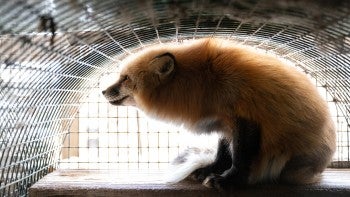
Meredith Lee/The HSUS
And why was this suffering allowed to continue unchecked for so long? While Grand River Fur Exchange was licensed by the Ohio Department of Natural Resources, Ohio does not have standards of care for fur farms or their slaughter practices. In fact, there is only one state-level law on fur farm welfare in the nation—New York’s ban on anal and genital electrocution of foxes. Further, in the U.S., there are no federal regulations related to the welfare, care or slaughter of animals farmed for their fur.
Our responders witnessed numerous violations of animal cruelty law which covers all animals in Ohio, including those living on fur farms. In Ohio, our rescuers discovered the electrocution device used on foxes, a typical practice fur farmers use to prevent damage to the animal's pelt when they are killed.
In 2011, the U.S. Department of Agriculture fined and prohibited the operator of this place from engaging in the breeding and sale of wild animals, yet the facility continued to do so, apparently without further USDA enforcement. There were very clear harms that resulted from this failure of enforcement, and it is difficult not to wonder how equally horrific it must be for animals at similar operations in Ohio and elsewhere.
We remain committed to creating a world in which no animal must suffer on such cruel “farms” such as this one. You can join us in our mission by pledging never to buy a fur product, by not liking and commenting on social media posts featuring wild animals kept as pets, and by opting for effective and commercially available garden deterrents that don’t require farming predators for their urine.
There’s no end to the good we can do for animals if we come together in solidarity for a world that prevents this cruelty by treating animals with the respect they deserve.
